Citrix 1Y0-440 - Architecting a Citrix Networking Solution
Scenario: A Citrix Architect needs to deploy SAML integration between NetScaler (Identity Provider) and ShareFile (Service Provider). The design requirements for SAML setup are as follows:
NetScaler must be deployed as the Identity Provider (IDP).
ShareFile server must be deployed as the SAML Service Provider (SP).
The users in domain workspacelab.com must be able to perform Single Sign-on to ShareFile after authenticating at the NetScaler.
The User ID must be UserPrincipalName.
The User ID and Password must be evaluated by NetScaler against the Active Directory servers SFO-ADS-001 and SFO-ADS-002.
After successful authentication, NetScaler creates a SAML Assertion and passes it back to ShareFile.
Single Sign-on must be performed.
SHA 1 algorithm must be utilized.
The verification environment details are as follows:
Domain Name: workspacelab.com
NetScaler AAA virtual server URL https://auth.workspacelab.com
ShareFile URL https://sharefile.workspacelab.com
Which SAML IDP action will meet the design requirements?
Which request can a Citrix Architect utilize to create a NITRO API command to add a NetScaler appliance with NSIP address 10.102.29.60 to the cluster?
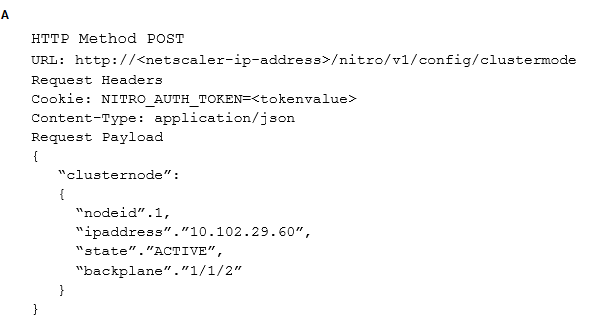
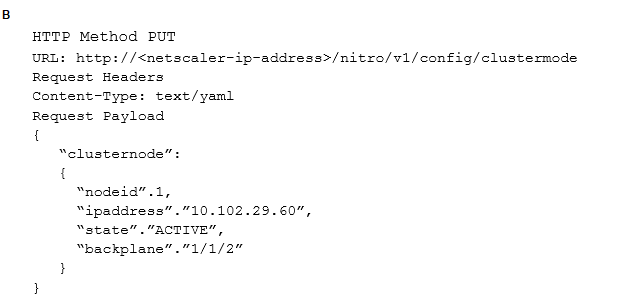
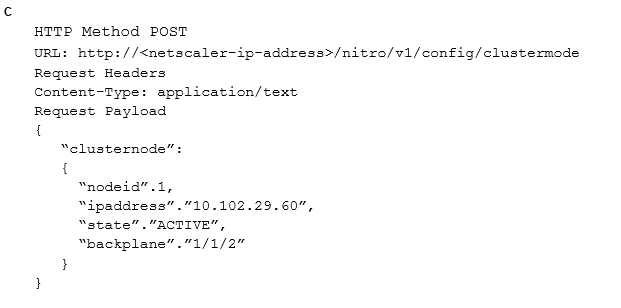
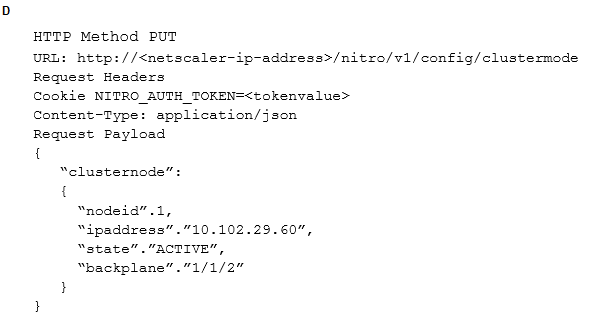
Scenario: A Citrix Architect needs to design a hybrid XenApp and XenDesktop environment which will include Citrix Cloud as well as resource locations in an on-premises datacenter and Microsoft Azure.
Organizational details and requirements are as follows:
Active XenApp and XenDesktop Service subscription
No existing NetScaler deployment
Global Server Load Balancing is used to direct connection requests to Location B, if the StoreFront server in Location B fails, connections should be directed to Location A.
Click the Exhibit button to view the conceptual environment architecture.
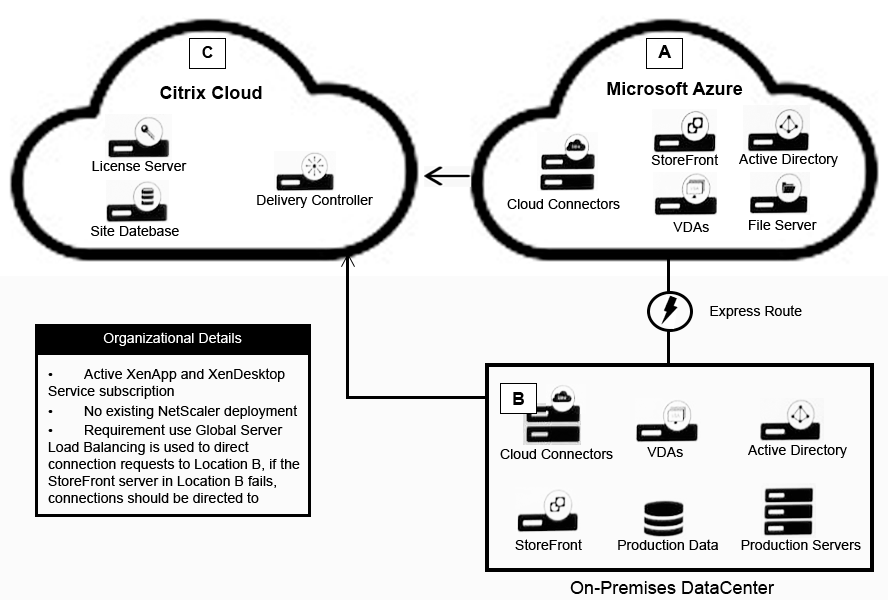
The architect should use _____ in Location A, and should use ________ in Location B. (Choose the correct option to complete the sentence.)
Scenario: A Citrix Architect needs to design a new multi-datacenter NetScaler deployment. The customer wants NetScaler to provide access to various backend resources by using Global Server Load Balancing (GSLB) in an Active-Active deployment.
Click the Exhibit button to view additional requirements identified by the architect.

Which GSLB algorithm or method should the architect use for the deployment, based on the stated requirements?
Scenario: A Citrix Architect has deployed two MPX devices, 12.0.53.13 nc and MPX 11500 models, in high availability (HA) pair for the Workspace labs team. The deployment method is two-arm and the devices are installed behind a CISCO ASA 5585 Firewall. The architect enabled the following features on the NetScaler devices. Content Switching, SSL Offloading, Load Balancing, NetScaler Gateway, Application Firewall in hybrid security and Appflow. All are enabled to send monitoring information to NMAS 12.0.53.13 nc build. The architect is preparing to configure load balancing for Microsoft Exchange 2016 server.
The following requirements were discussed during the implementation:
All traffic needs to be segregated based on applications, and the fewest number of IP addresses should be utilized during the configuration
All traffic should be secured and any traffic coming into HTTP should be redirected to HTTPS.
Single Sign-on should be created for Microsoft Outlook web access (OWA).
NetScaler should recognize Uniform Resource Identifier (URl) and close the session to NetScaler when users hit the Logoff button in Microsoft Outlook web access.
Users should be able to authenticate using either user principal name (UPN) or sAMAccountName.
The Layer 7 monitor should be configured to monitor the Microsoft Outlook web access servers and the monitor probes must be sent on SSL
Which monitor will meet these requirements?
Scenario: A Citrix Architect and a team of Workspacelab members have met for a design discussion about the NetScaler Design Project. They captured the following requirements:
Two pairs of NetScaler MPX appliances will be deployed in the DMZ network and the internal network.
High availability will be accessible between the pair of NetScaler MPX appliances in the DMZ network.
Multi-factor authentication must be configured for the NetScaler Gateway virtual server.
The NetScaler Gateway virtual server is integrated with XenApp/XenDesktop environment.
Load balancing must be deployed for the users from the workspacelab.com and vendorlab.com domains.
The logon page must show the workspacelab logo.
Certificate verification must be performed to identify and extract the username.
The client certificate must have UserPrincipalName as a subject.
All the managed workstations for the workspace users must have a client identifications certificate installed on it.
The workspacelab users connecting from a managed workstation with a client certificate on it should be authenticated using LDAP.
The workspacelab users connecting from a workstation without a client certificate should be authenticated using LDAP and RADIUS.
The vendorlab users should be authenticated using Active Directory Federation Service.
The user credentials must NOT be shared between workspacelab and vendorlab.
Single Sign-on must be performed between StoreFront and NetScaler Gateway.
A domain drop down list must be provided if the user connects to the NetScaler Gateway virtual server externally.
The domain of the user connecting externally must be identified using the domain selected from the domain drop down list.
On performing the deployment, the architect observes that users are always prompted with two-factor authentication when trying to assess externally from an unmanaged workstation.
Click the exhibit button to view the configuration.
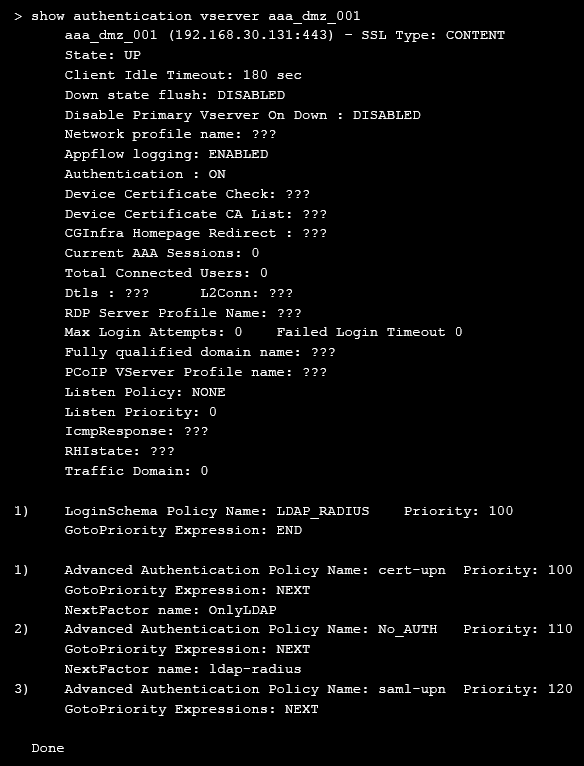
What should the architect do to correct this configuration?
_________ content type supports sending NITRO commands to NetScaler. (Choose the correct option to complete sentence.)
Scenario: A Citrix Architect has deployed an authentication setup for the load balancing virtual server for the SAP application. The authentication is being performed using RADIUS and LDAP. RADIUS is the first factor, and LDAP is the second factor in the authentication. The Single Sign-on with SAP application should be performed using LDAP credentials. Which session profile should be used to perform the Single Sign-on?
Scenario: A Citrix Architect has set up Citrix ADC MPX devices in high availability mode with version 12.0.53.13 nc. These are placed behind a Cisco ASA 5505 firewall. The Cisco ASA firewall is configured to block traffic using access control lists. The network address translation (NAT) is also performed on the firewall.
The following requirements were captured by the architect during the discussion held as part of the Citrix ADC security implementation project with the customers security team:
The Citrix ADC MPX device:
should monitor the rate of traffic either on a specific virtual entity or on the device It should be able to mitigate the attacks from a hostile client sending a flood of requests. The Citrix ADC device should be able to stop the HTTP TCP. and DNS based requests
needs to protect backend servers from overloading
needs to queue all the incoming requests on the virtual server level instead of the service level
should provide access to resources on the basis of priority
should provide protection against well-known Windows exploits virus-infected personal computers, centrally managed automated botnets, compromised webservers, known spammers/hackers, and phishing proxies
should provide flexibility to enforce the desired level of security check inspections for the requests originating from a specific geolocation database.
should block the traffic based on a pre-determined header length. URL length and cookie length. The device should ensure that characters such as a single straight quote ('): backslash (\); and semicolon (;) are either blocked, transformed, or dropped while being sent to the backend server.
Which security feature should the architect configure to meet these requirements?
Scenario: Based on a discussion between a Citrix Architect and a team of Workspacelab members, the MPX Logical layout for Workspacelab has been created across three (3) sites.
They captured the following requirements during the design discussion held for a Citrix ADC design project:
All three (3) Workspacelab sites (DC, NDR, and DR) will have similar Citrix ADC configurations and design.
Both external and internal Citrix ADC MPX appliances will have Global Server Load Balancing (GSLB) configured and deployed in Active/Passive mode.
GSLB should resolve both A and AAA DNS queries.
In the GSLB deployment, the NDR site will act as backup for the DC site, whereas the DR site will act as backup for the NDR site.
When the external Citrix ADC replies to DNS traffic coming in through Cisco Firepower IPS, the replies should be sent back through the same path.
On the internal Citrix ADC, both the front-end VIP and backend SNIP will be part of the same subnet.
The external Citrix ADC will act as default gateway for the backend servers.
All three (3) sites, DC, NDR, and DR, will have two (2) links to the Internet from different service providers configured in Active/Standby mode.
Which design decision must the architect make the design requirements above?



